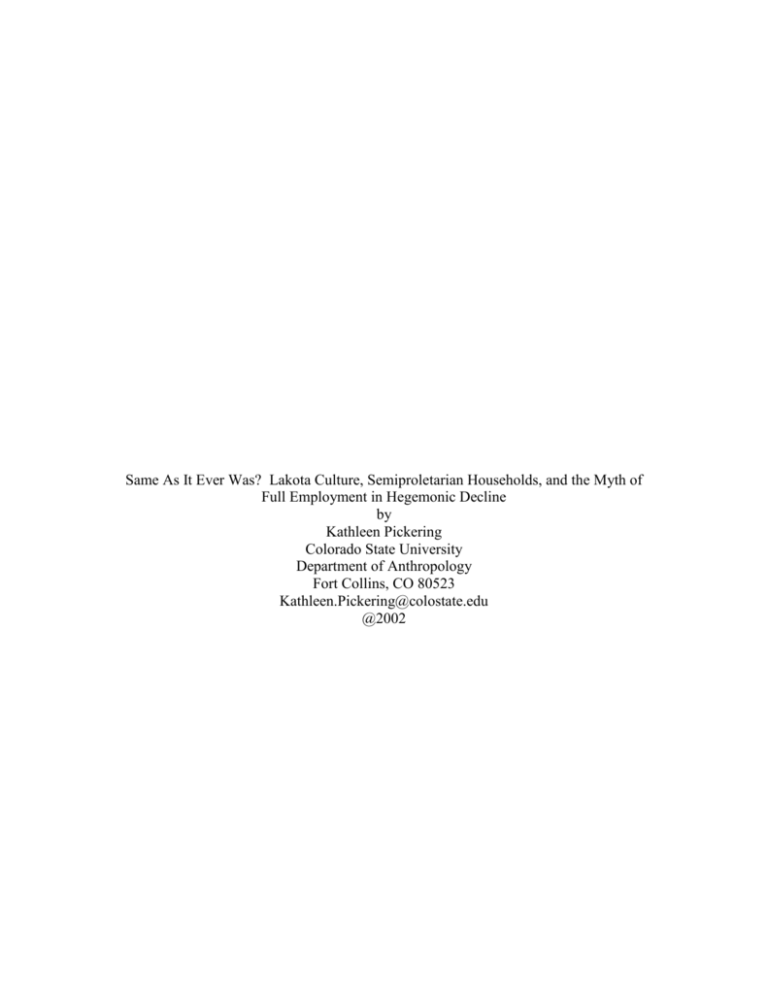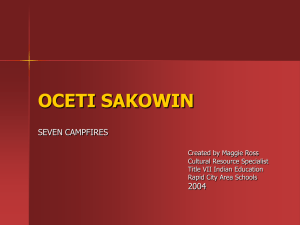Same As It Ever Was - Institute for Research on World
advertisement

Same As It Ever Was? Lakota Culture, Semiproletarian Households, and the Myth of Full Employment in Hegemonic Decline by Kathleen Pickering Colorado State University Department of Anthropology Fort Collins, CO 80523 Kathleen.Pickering@colostate.edu @2002 Introduction Economic anthropologists have argued that all economies have two sides, one side regulated by socially mediated relations, and one side regulated by impersonal market trade (Gudeman 1998). Part of the project of constructing ‘modernity’ by the capitalist hegemons of the world-economy has been to promote the view that the impersonal ‘free’ market was the only efficient method for organizing economic production and exchange. Those societies with predominantly socially mediated economic relationships have been labeled “backward,” “primitive,” and “traditional,” resisting the progress that would transform them into economically wealthy ‘modern’ societies (Friedman 1994: 95; Taylor 1996: 38-39). With the growing “crises of modernity,” increasing numbers of indigenous societies with limited ties to capitalist markets are engaged in what is being characterized as cultural resistance, resurgence, or re-emergence. One explanation for this bursting forth of indigenous identity is that declining hegemonic power is allowing for cultural and political expressions that had been quashed in earlier periods (Friedman 2000). Another explanation might be that the behaviors that are now interpreted as resistance, resurgence, and re-emergence were ongoing aspects of indigenous struggle that were never noticed because they contradicted the hegemonic imagination. This leaves the challenging question of what changes and what stays the same in the process of worldsystem incorporation. While myriad changes are apparent in the material items produced and exchanged, the parties involved in exchange, political or military interventions, and the wealth accumulated by core interests from this exchange, less is understood about the local continuities that would make such resistance, resurgence and re-emergence possible 1 hundreds of years after initial incorporation. As Jonathan Friedman has stated, “the voices of the Other are the voices of real people struggling for control over their conditions of existence, conditions that have been denied to them at the very least. This struggle is not about culture as such, but about social identity of a particular kind, indigenous identity, which is constituted around cultural and experiential continuities that are only poorly mirrored in Western categories, not least, in anthropological categories” (2000: 141). While macro-level analysis highlights the volatility of conditions within the modern world-system, micro-level analysis of households might suggest that in fact volatile conditions are the norm, and that the issue of continuity rests with the cultural strategies for adapting to this uncertainty. This paper suggests that aspects of the organization or logic of indigenous economies persist, but were never noticed because they contradict the hegemonic imagination of fully commoditized economic life. Failure to appreciate cultural continuities in the economic adaptations of peripheral indigenous societies stems from two assumptions about the capitalist world-system. First, the agency of the world-economy was commonly placed exclusively in the hands of the hegemonic core powers. As a result, changes in economic organization and logic in the core were automatically taken to be changes in economic organization and logic in the periphery. However, as Thomas Hall has illustrated, the experience of the capitalist world-system is not of one cloth, but rather based on a dynamic and reversible relationship between core and peripheral areas whereby the degree of incorporation affects peripheral societies, and their reactions in turn shape the incorporation process (Hall 2000: 241-242; 1989: 18-21). “Our understanding of past patterns has been hampered by relative concentration on coregenerated processes and neglect of frontiers....[F]ar peripheries are as relevant as the 2 core. This is not a matter of political correctness or humane inclusiveness - though they are important - but a matter of valid theory building” (Hall 2000: 237). A second reason indigenous cultural continuities are often overlooked is because global trends have been privileged over local conditions of everyday life, rather than treating them dialectically as Braudel suggested. As a result, many of the actual structures through which human life are conducted remain hidden. As Wilma Dunaway illustrates, fundamental processes of capital accumulation and unequal exchange are taking place within semiproletarian households around the world, but remain unrecognized because they are not embodied in the impersonal, individualized, and commodified forms that the imagination of ‘modernity’ has constructed for the social sciences (Dunaway 2001; see also Wallerstein 2001). In particular, the role of women, kinship, subsistence, and socially embedded economic practice are rarely discussed, because the hegemonic perspective of fungible labor pools, commodified resources, and impersonal markets create blinders to the perspectives and practices of those outside the core. Using Peter Burns deliberately feudal imagery, the world-economy is a series of manor houses surrounded by seas of poverty (1999: 125), and the scholars are in the manor houses. Hegemonic visions of an imaginary capitalism have prevented a greater appreciation of the continuities of human life under capitalism, and the importance of currently hidden social structures in future transformations of the modern world-system. The Oglala Lakota tribe of the Pine Ridge Indian Reservation in rural, southwestern South Dakota exemplifies the importance of locating cultural continuities. Hegemonic power has certainly been exercised to disrupt Lakota human activity, resources, and political organization for the benefits of capitalist production. At the same 3 time, Lakota communities have been vehement in their construction and maintenance of identity spaces. Furthermore, in contradiction to the hegemonic view of individualized and impersonal market penetration of Lakota society, the actual social structure surrounding local practices of these Lakota communities is remarkably unchanged. This paper is based on research started in the summer of 2001 exploring the potential of social relationships to serve as economic structures on the Pine Ridge Reservation, based on surveys administered to a random sample of 60 households. Initial results indicate that the social cohesion of particular communities, and the tiyospaye or extended family structure in particular, continue to have salience in the ways that economic resources and opportunities are distributed across the reservation. By adopting a Lakota perspective on their experience with the world-economy, the critical variables become kinship, women, subsistence, ceremonial safety nets, and a distinct lack of ideological commitment to transforming into impersonal market individuals. Interesting parallels to the Lakota experience emerge from the social history of English society before British hegemony in 1815, and during the onset of British hegemonic decline in the 1880s, adding further weight to the question of whether hegemonic visions of an imaginary capitalism have blinded us to a greater appreciation of the continuities of human life. I. Lakota Economic Practice in U.S. Hegemonic Decline Despite more than a hundred years of political incorporation into the United States, the Lakota remain on the far edge of the economic periphery. While U.S. government policies have been relentless in forcing Lakota transformation into individualistic, cash-based market participants, the results have been scanty at best. 4 Individual allotment of tribal lands, vocationally oriented mandatory education, boss farmers instructing Lakota land-owners in commodity agriculture, and relocation of Lakota workers to urban areas were just some of the methods the U.S. government used to assimilate Lakota households into the market economy (Pickering 2000:64-66, 93-96). Nevertheless, formal economic markets have been slow to form on Pine Ridge, leaving it the poorest county in the United States for the past 30 years. The arguable benefits of capitalist production were concentrated in a series of failed experiments with factory work on the reservation in the 1960s, like search lights in the darkness that approached without warning, blazed for a moment, and then moved on. Given the insubstantial nature of any particular market activity on Pine Ridge, the question becomes not just what people are doing in Pine Ridge, but how economic life is organized? Three interrelated answers emerge regarding the irregular blending of market and non-market activities, the social structure of economic practice, and the integration of minimal forms of government transfer payments and support as one of a longer list of potential household resources. One result of the lack of formal economic markets is that Lakota people engage in a broad mixture of economic activities, both within a given time period and over the course of their lives. All the households who participated in the random sample were simultaneously engaged in a broad mixture of activities, including short-term, part-time wage work, informal exchanges of services, home-based enterprise, subsistence practices, and Social Security or pension benefits. There are not enough wage jobs available on the reservation, and many of the wage labor opportunities are short-term, temporary, or parttime, making it unlikely any individual will find real job security. From the 2001 5 surveys, only 57% of the households had at least one wage worker, and that figure drops to 48% when the measure is a least one full-time wage worker. This is consistent with the 1990 U.S. Census that reported 32.7% unemployment for Pine Ridge, with a full 53% of the working age population in Pine Ridge not "in the labor force." Furthermore, the 1990 Census reports that 57% of those with jobs were employed less than half the year. People must access resources and support outside of formal wage labor markets. For example, from the 2001 surveys, 78.3% of the households engaged in subsistence activities, using wild food resources at least part of the year, which implied time either to hunt and gather or to network socially with those who do. Second, economic practices of these Lakota communities are deeply embedded in social relationships. The tiyospaye, or extended family unit, is most often cited as the defining feature in relation to social, political, and cultural organization, and is central to the non-market or social economy. Information about commodified and non- commodified economic opportunities on the reservation flows through social networks of relatives and friends. Tribal politics continues to be a proxy for kinship relationships, as it was prior to reservation creation. The lion’s share of external resources flow through tribal governmental structures. For example, 58% of the available jobs are with either the federal or tribal government. People commonly observe that tribal politicians and government workers help only their own family and friends, but interpret this as nepotism only when they are outside of that social network. Cultural conventions of exchange provide some of the material support lacking in formal markets. One indication of the ongoing reliance on non-market, socially- embedded economic activities providing support is the response to whether households 6 participated in ceremonies, powwows, funerals, or other community events. Virtually all households did participate in these events, which involve distributions of food and household goods, as well as reinforcement of extended and fictive kinships relations, and critical exchanges of information about scarce resources and opportunities currently available across the reservation. The average level of participation in these events was 26 per year, each of which may run continuously for twenty-four hours a day over two to four days. The range of participation was from several to more than 200 per year. Viewed in light of the typical wage work hours of 9 to 5, the prominence of this social economy becomes apparent. The responses to several other questions emphasize the importance of participating in the socially and culturally embedded economy of the reservation over capitalist market activities, and the reliance on informal institutions rather than market institutions for financial support. As reported in Table 1, respondents were asked the open-ended question of what their household would do if they did not have money to pay for a utility bill, and then what they would do if their first option was not available, and then if their second option was not available. The market-based options of trying for a bank loan or increasing wage work were insignificant compared to the prominence of family and friends, and tribal government programs and offices. These market-based options increased only marginally as respondents provided their second and third options. Access to bank loans are limited to those with regular and certain access to the cash economy, and households know whether that is part of their choice set or not. If a bank loan is not their first response, then it is unlikely to appear at all. The low numbers associated with getting a job also reflect the limited choice set of most households, 7 whereas the option of making and selling something is slightly more flexible, with entrepreneurship increasing from 10.5% of initial responses to 21% of households’ total responses. The resources that run through these kin-based networks are not necessarily those that would be associated with commodities or markets. People use social networks to learn of rummage sales or second- hand goods donations, and use the same networks to redistribute goods obtained second-hand from donations or visits to the dump. Social and spiritual events are similarly announced by word of mouth through kin-based networks. The location of ripe wild plants, labor needed to host ceremonial events, potential buyers for the products of home-based enterprises, and information about special programs or tribal opportunities are all accessed through social networks. Within these social conditions, the identity of Lakota individuals is not defined by their job, as it tends to be in mainstream industrialized societies. In initial conversations, instead of asking “where do you work?” or “what do you do?”, people instead will ask about your relationships, through birth, marriage, or friendship, to establish any common social links that you might have. These, in turn, are the relationships that define your access to resources and information, and that provide the continuity that is lacking in the market economy of wage jobs. There is tremendous risk involved in not investing enough time in these social networks. As one Lakota woman explained: “It’s almost a belief, like if we have food and if somebody doesn’t have food, or they’re hungry, you feed that person, you give them food. Because you know as long as you do that, you’ll never be hungry yourself...Things come unexpectedly, so to speak. Things make a way, they all work theirselves out. Like this rummage over there that 8 people are waiting on to get, people don’t just get things for theirselves. Like they’ll call people and say, ‘well, what size does your son wear?’ and this and that, and ‘oh, well, I go this,’ and everybody kind of looks out for everybody. [And for people who failed to participate in this reciprocal network,] people I don’t think would speak to them. They would sort of be like outcasts, basically. I mean people would still be like ‘oh, hi, how are you,’ but as far as people coming to visit or people invite people to things, no I don’t think. Because see, then they have separated themselves. Because in order to be involved in something, you have to be involved. You have to take time enough to ask, ‘do you need help?’ or ‘is there anything I can do?’ A final aspect of the varied blend of economic support on the reservation is government welfare. In 1996, the U.S. government enacted welfare reform that, for the first time, required that people receiving welfare, who are overwhelmingly women with young children, would have to engage in wage work to continue receiving welfare benefits (Pickering 2001). Prior to welfare reform, single-parent families with children were eligible for AFDC (Aid to Families with Dependent Children) simply based on their overall income and asset levels. The government strategy behind welfare reform was to end ‘welfare dependency’ by encouraging welfare recipients to find wage labor positions. Implicit in the rationale for reform was the belief that full employment was possible, and that only those with jobs should be eligible for welfare supplementation, hence the inclusion of the term ‘Temporary’ in the new program title, Temporary Assistance to Needy Families (TANF). The assumption of full employment rings particularly hollow in a rural poverty area like Pine Ridge. Furthermore, many Lakota people interpret welfare payments as 9 U.S. government obligations under the treaty negotiated at Fort Laramie in 1868 in exchange for massive land cessions. The USDA Surplus Commodities program on reservations is explicitly described as the continuation of rations promised under treaty rights. While welfare was never viewed as enough to support a household, it was considered one of the mix of economic resources that make household survival possible. As illustrated in Table 3, when surveyed households were asked about welfare, 38% had participated in either TANF or AFDC, but only 15% were currently involved in the TANF program. Of those participants, none had a job in the private sector; 55% were working in government offices that were never planning to create new positions for these TANF workers. The remaining 45% had not yet been able to find a position but had avoided being sanctioned off the program so far. Of the 23 households that had ever received welfare, 8 had been part of the TANF program but withdrew for several reasons (see Table 3). In every instance, both kin-based networks and combining economic activities and resources made it possible to continue household survival without TANF. Table 1 Self-Identified Potential Sources of Funds To Pay Utility Bills a Source of Funds First Reported Source of Funds b Reported As a Potential Source of Funds c Tribal Government 36.8 47 10 Family/Friends 26.4 42 Entrepreneurship 10.5 21 Bank loan 10.5 15.8 Get a job 8.8 10.5 Go without electricity 7 22.5 Households were asked to identify three possible sources of funds in the event they could not a pay their utility bills (n=60). Survey Question: If you didn’t have the money to pay for utilities, what would you do? And if this option wasn’t available? And if this second option wasn’t available? b Percent of households for whom the source of funds was reported first c Percent of households who identified the source in any of their three answers. The percentages do not necessarily sum to one. 11 In contrast, the non-market options of tribal government or family and friends increased significantly to 47% and 42% respectively when second and third options were included. Reliance on tribal government implies participation in local social networks, as well as the continuing traditional expectation that the role of tribal government is to redistribute goods based on individual needs. It is also notable that almost a quarter of the sample households were willing to go without if they were faced with a cash shortfall, although it was the first choice for only 7% of households. This means that, absent social and political networks, people can and will simply do without. Similar results were obtained with a series of open-ended questions about the people who provided various forms of support to the household, illustrated in Table 2. Out of a total of 245 responses from the 60 random households, 76.5% of the responses indicated an immediate or extended family member as the source of support. Out of the remaining 23.5% of responses that did not indicate family members as the source of support, 10.5% were friends, 5% were tribal government support, and 8% were other relationships like religious leaders, co-workers, and general community members or neighbors. It is critical to see that family relationships are the most significant defining feature in how resources are distributed and redistributed across the reservation, not just general residence in the reservation community. It is also critical to look at gender specifically, since 97 of the 187 family responses mentioned the gender of the relative, and 69% of those responses mentioned a female relative, indicating the greater importance of women in maintaining these kin-based economic networks. While no woman has ever been president of the Oglala Sioux tribal government, if you want to know how the economy works in Pine Ridge, you had better ask the women. Table 2 Who Provides Support to Your Household? By Relationship Percentage (n=245) Immediate/Extended Family 76.5% Friends 10.5% Tribal Government 5% 12 Other (religious leader, co-worker, neighbor) 8% By Gender of Supporting Person Percentage (n=97) Female Relative 69% Male Relative 31% The resources that run through these kin-based networks are not necessarily those that would be associated with commodities or markets. People use social networks to learn of rummage sales or second- hand goods donations, and use the same networks to redistribute goods obtained second-hand from donations or visits to the dump. Social and spiritual events are similarly announced by word of mouth through kin-based networks. The location of ripe wild plants, labor needed to host ceremonial events, potential buyers for the products of homebased enterprises, and information about special programs or tribal opportunities are all accessed through social networks. Within these social conditions, the identity of Lakota individuals is not defined by their job, as it tends to be in mainstream industrialized societies. In initial conversations, instead of asking “where do you work?” or “what do you do?”, people instead will ask about your relationships, through birth, marriage, or friendship, to establish any common social links that you might have. These, in turn, are the relationships that define your access to resources and information, and that provide the continuity that is lacking in the market economy of wage jobs. There is tremendous risk involved in not investing enough time in these social networks. As one Lakota woman explained: “It’s almost a belief, like if we have food and if somebody doesn’t have food, or they’re hungry, you feed that person, you give them food. Because you know as long as you do that, you’ll never be hungry yourself...Things come unexpectedly, so to speak. Things make a way, they all work theirselves out. Like this rummage over there that people are waiting on to get, people don’t just get things for theirselves. Like they’ll call people and say, ‘well, what size does your son wear?’ and this and that, and ‘oh, well, I go this,’ and everybody kind of looks out for 13 everybody. [And for people who failed to participate in this reciprocal network,] people I don’t think would speak to them. They would sort of be like outcasts, basically. I mean people would still be like ‘oh, hi, how are you,’ but as far as people coming to visit or people invite people to things, no I don’t think. Because see, then they have separated themselves. Because in order to be involved in something, you have to be involved. You have to take time enough to ask, ‘do you need help?’ or ‘is there anything I can do?’ A final aspect of the varied blend of economic support on the reservation is government welfare. In 1996, the U.S. government enacted welfare reform that, for the first time, required that people receiving welfare, who are overwhelmingly women with young children, would have to engage in wage work to continue receiving welfare benefits (Pickering 2001). Prior to welfare reform, single-parent families with children were eligible for AFDC (Aid to Families with Dependent Children) simply based on their overall income and asset levels. The government strategy behind welfare reform was to end ‘welfare dependency’ by encouraging welfare recipients to find wage labor positions. Implicit in the rationale for reform was the belief that full employment was possible, and that only those with jobs should be eligible for welfare supplementation, hence the inclusion of the term ‘Temporary’ in the new program title, Temporary Assistance to Needy Families (TANF). The assumption of full employment rings particularly hollow in a rural poverty area like Pine Ridge. Furthermore, many Lakota people interpret welfare payments as U.S. government obligations under the treaty negotiated at Fort Laramie in 1868 in exchange for massive land cessions. The USDA Surplus Commodities program on reservations is explicitly described as the continuation of rations promised under treaty rights. While welfare was never viewed as enough to support a household, it was considered one of the mix of economic resources that make household survival possible. As illustrated in Table 3, when surveyed households were asked about welfare, 38% had participated in either TANF or AFDC, but only 15% were currently involved in the TANF program. Of those participants, none had a job in the private sector; 55% were working in government offices that were never planning to create new positions for these TANF workers. The remaining 45% had not yet been able to find a position but had avoided being sanctioned off the program so far. Of the 23 households that had ever received welfare, 8 had been part of the TANF program but withdrew for several reasons (see Table 3). In every instance, both kin-based networks and combining economic activities and resources made it possible to continue household survival without TANF. Table 3 Household History with Welfare Percentage (n=60) Number 14 Received AFDC or TANF in past 38% (n=23) Currently Receive TANF 15% (n=9) With Private Sector Job 0 With Government Job 5 With No Job Yet 4 Received TANF but stopped 13% (n=8) Found local job 15 2 Found job out of state, then returned 1 Enrolled in school part-time 1 Sanctioned off 2 Eligible for Disability Benefits 1 Transferred Child Custody 1 II. Drawing Parallels from British Hegemony II. Drawing Parallels from British Hegemony These aspects of Lakota economic and social life may seem to be quaint features of a culturally distinct and marginalized group within the world-system allowed 16 expression due to the disinterest or disregard of declining hegemonic forces. However, these practices have been in place on Pine Ridge both before and after the hegemonic rise of the U.S. Furthermore, similar socially embedded economic practices have been observed among indigenous people and local communities around the globe within the current world-system (e.g., Annis 1987; Halperin 1990; Mingione 1991). The social history of England, again both before and after British hegemonic rise, provides further justifications for taking seriously the irregularity of capitalist wage markets, the centrality of kinship, and the ambiguous position of government transfer payments in luring communities into an ideological dedication to wage work. Some of these quaint practices begin to emerge as human trends within innumerable cultural contexts that have been ongoing below the gaze of the hegemonic manor houses. Briefly, John Rule’s study “The Experience of Labour in Eighteenth-Century English Industry” provides a dynamic picture of households in England combining wage work in mining and manufacturing with a broad array of home-based and agricultural pursuits, born largely out of the uncertainty and irregularity associated with formal employment (1981). As a student of E.P. Thompson, he expands on themes of Thompson about the issues of work-discipline and the effects of industrial capitalism on households (Thompson 1967). Some of these distinctions may be attributable to differences between urban and rural areas (Harrison 1986). Nevertheless, we are left with the question of how much individual market behavior was practiced even at the dawn of British hegemony. 17 Similar questions are raised by David Cressy’s work on “Kinship and Kin Interaction in Early Modern England” (1986). While we are all familiar with the importance of family trees to the English aristocracy, Cressy demonstrates that kin-based networks were also essential to the economic practices of the lower classes. Once again, this research calls into question the picture of fully independent individuals entering impersonal market relationships as they bring capitalism to new ends of the earth. Finally, Krishan Kumar’s examination of “Unemployment as a problem in the development of industrial societies” focuses on the ongoing reality of unemployment even within the heart of British hegemony (1984). Kumar traces the reluctance of the state to limit income supplementation to those involved with the irregularities of wage work until the 1890s, when the term ‘unemployment’ was first analyzed in the wake of British hegemonic decline. The market treatment of labor is simply insufficient to offset the uncertainty of wage work against the security of alternatives within the social economy. As E.P. Thompson observed, “The irregular labour rhythms...help us to understand the severity of mercantilist doctrines as to the necessity for holding down wages as a preventative against idleness, and it would seem to be not until the second half of the eighteenth century that ‘normal’ capitalist wage incentives begin to become widely effective” (1967: 81). The history of U.S. government inducements to Lakota laborers mirror this pattern, as first wage labor was required to receive rations guaranteed by treaty, and then rations were eliminated for those who were engaged in wage work, because they were viewed as self-supporting. Similar themes can be located in the current TANF work 18 requirements, where Lakota households will receive the same level of cash support, but now must perform wage work hours to receive it. III. The Hegemonic ‘Imagination’ If the picture of individuals fully employed by the capitalist market structure living in a fully commodified economy does not even hold for the central core during periods of hegemonic dominance, how has this mental imagery been created and maintained as the standard against which indigenous societies are measured? Marx’s notion that it is not consciousness that determines existence, but social existence that determines consciousness raises the question of what scholars peering from hegemonic manor houses can actually perceive of the material realities of households practicing within the seas of poverty. Part of the answer may lie in the concept of the imaginary developed recently by Maurice Godelier in exploring the enigma of the gift (1999). Godelier states “that all power contains ‘kernels of imaginary material’ which were necessary to its formation and reproduction. But the imaginary has power only when it becomes a belief, a standard of behavior, a source of morality” (1999: 31). For those looking out of the hegemonic manor houses, the imaginary completeness of capitalism has become a belief, a standard of behavior from which to judge the level of development, assimilation, or social health of those in the sea. The power of this belief is evident in the draconian efforts of the state to impose on those with a different social existence the consciousness necessary to internalize the imaginary ability of capitalism to meet all human needs through impersonal markets, individuality, and total commodification. 19 Like Gabriel Garcia Marquez’ The Autumn of the Patriarch, elites of U.S. hegemony are surprised to learn that the emulation of American society they adored was born not of love but of force. The ‘freedom’ they offered tribal people from their communal land holdings is now understood from a Lakota perspective as an attack on ‘the commons,’ lands that made survival possible within the incomplete reality of capitalism. The ‘democratic individuality’ they offer tribal people from the nepotism and inequalities of traditional tribal sovereignty is understood from a Lakota perspective as an attack on the social and economic fabric of their society. The ‘opportunities’ they provide individual tribal members to place their commodified labor on the market are understood from a Lakota perspective as the extension of kin-based networks to another irregular and uncertain resource from the materially inadequate capitalist economy which, if forced, could undermine the genuine security provided through the social economy. The imaginary capitalist market place of full employment, satisfying all material needs and future security for individuals, has never been part of the social existence of the Lakota, and therefore has never created an internalized commitment to wage work or the market economy. As one Lakota woman explained, “It's like the people during the Depression on the outside, oh my God it was terrible, and out here it was like, it was no different. They didn't have running water, they didn't have good housing, they didn't have good education, they didn't have the right kind of food, so you know here, the Depression was not really that big of deal.... I think that's another reason why this particular place won't get hit so hard is because they're not used to having everything anyway.” 20 These profoundly local trends are critical for understanding what may emerge in the wake of capitalist hegemonic decline. As those who were ambiguously “freed” from the constraints of feudal land relations became the labor base for the new capitalist mode of production, so those now ambiguously “freed” from capitalist relations of production may be the key to future transformations of the world-system. U.S. hegemonic decline is revealing to core elites the shortfalls of capitalism that have been apparent to these Lakota communities all along. While the material objects and activity sets may change, the social reality of survival is the same as it ever was. Bibliography Annis, Sheldon, 1986, God and Production in a Guatemalan Town, Austin: University of Texas Press. Burns, Peter M., 1999, An Introduction to Tourism and Anthropology, London: Routledge. Cressy, David, 1986, “Kinship and Kin Interaction in Early Modern England,” Past and Present 113(November): 38-69. Dunaway, Wilma A., 2001, “The Double Register of History: Situating the Forgotten Woman and Her Household in Capitalist Commodity Chains,” Journal of WorldSystems Research VII(1):2-29. Friedman, Jonathan, 2000, “Indigenous Struggles and the Discreet Charm of the Bourgeoisie,” in Perplexities of Identification: Anthropological Studies in Cultural Differentiation and the Use of Resources, Henk Driessen and Ton Otto, editors, pp. 141-163, Aarhus: Aarhus University Press. Friedman, Jonathan, 1994, Cultural Identity and Global Process, London: Sage Publications. Garcia Marquez, Gabriel, 1976, Autumn of the Patriarch, Gregory Rabassa, translator, New York: Harper and Row. Godelier, Maurice, 1999, The Enigma of the Gift, Chicago: University of Chicago Press. 21 Gudeman, Stephen, 1998, “Banishing the Other from the Market: the Development Economics of W. Arthur Lewis,” Paideuma 44: 125-138. Hall, Thomas D., 2000, “Frontiers, Ethnogenesis, and World-Systems: Rethinking the Theories,” in A World-Systems Reader: New Perspectives on Gender, Urbanism, Cultures, Indigenous Peoples, and Ecology, Thomas D. Hall, editor, pp. 237-270, Lanham, MD: Rowman & Littlefield Publishers, Inc. Hall, Thomas D., 1989, Social Change in the Southwest, 1350-1880, Lawrence: University of Kansas. Halperin, Rhoda, 1990, The Livelihood of Kin: Making Ends Meet ‘The Kentucky Way,” Austin: University of Texas Press. Harrison, Mark, 1986, “The Ordering of the Urban Environment: Time, Work and the Occurrence of Crowds 1790-1835,” Past and Present 110 (February): 134-168. Kumar, Krishan, 1984, “Unemployment as a Problem in the Development of Industrial Societies: the English Experience,” The Sociological Review 32(2): 185-233. Mingione, Enzo, 1991, Fragmented Societies: A Sociology of Economic Life Beyond the Market Paradigm, Oxford: Basil Blackwell. Pickering, Kathleen, 2001, “Legislating Development Through Welfare Reform: Indiscernible Jobs, Insurmountable Barriers, and Invisible Agendas on the Pine Ridge and Rosebud Indian Reservations, Political and Legal Anthropology Review 24(1): 38-52. Pickering, Kathleen, 2000, Lakota Culture, World Economy, Lincoln: University of Nebraska Press. Rule, John, 1981, The Experience of Labour in Eighteenth-Century English Industry, New York: St. Martin’s Press. Taylor, Peter J., 1996, The Way the Modern World Works: World Hegemony to World Impasse, New York: John Wiley & Sons. Thompson, E.P., 1967, “Time, Work-Discipline, and Industrial Capitalism,” Past and Present 38: 56-97. Wallerstein, Immanuel, 2001, Unthinking Social Science: The Limits of NineteethCentury Paradigms, Second Edition, Philadelphia: Temple University Press. 22







